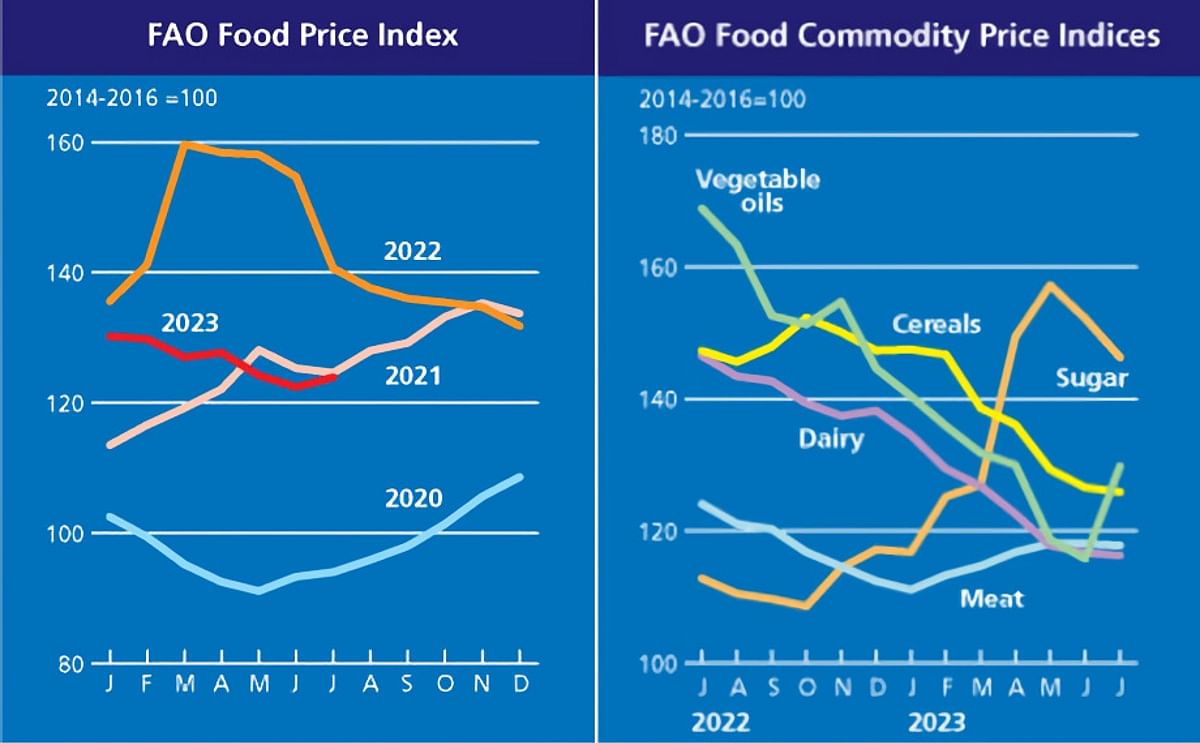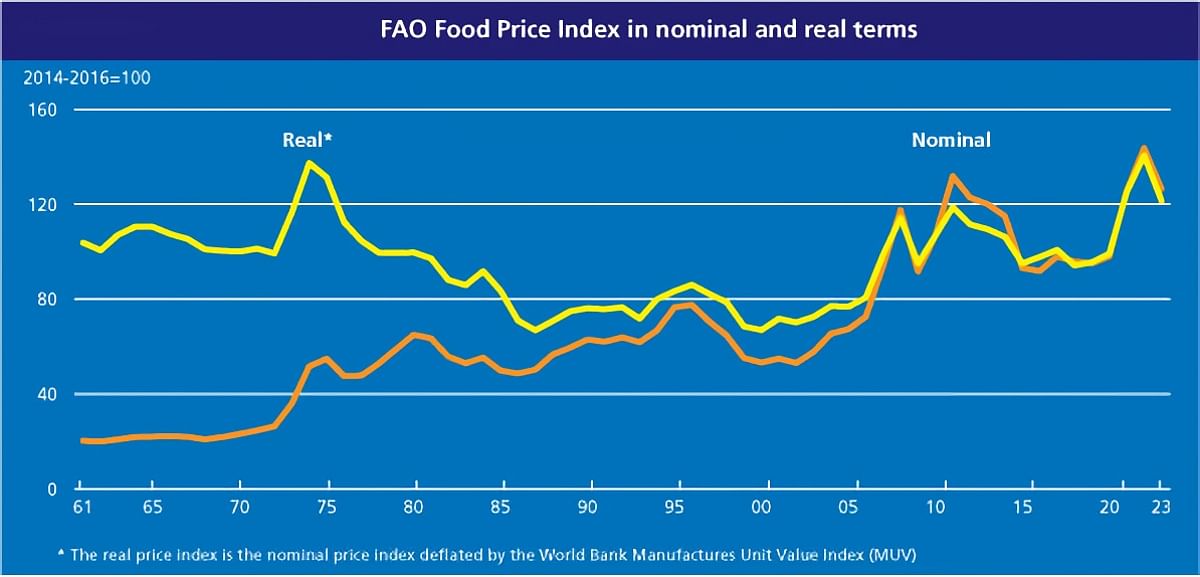FAO Food Price Index rebounds slightly in July
FAO Food Price Index rebounds slightly in July

The FAO Food Price Index* (FFPI) averaged 123.9 points in July 2023, up 1.5 points (1.3 percent) from June but remaining 16.6 points (11.8 percent) below its value in the corresponding month last year.
The FFPI’s rebound in July was led by a solid rise in the vegetable oils price index, partially offset by a significant decline in the sugar price index, together with small decreases in the price indices for cereals, dairy and meat.
The FAO Cereal Price Index averaged 125.9 points in July, down 0.7 points (0.5 percent) from June and 21.3 points (14.5 percent) below its value a year ago. This month’s slight decline stems from a fall in international coarse grain prices, which declined by 4.8 percent from June.
International maize prices continued their downward trend due to increased seasonal supplies from ongoing harvests in Argentina and Brazil and potentially higher-than-initially-anticipated production in the United States of America, where conditions slightly improved and the planted area was revised upwards. Among other coarse grains, world prices of sorghum declined in tandem with those of maize, while world barley prices were nearly stable, influenced by spillover effects from wheat markets.
By contrast, international wheat prices rose by 1.6 percent, marking their first month-on-month increase in nine months, mainly driven by the uncertainty over Ukraine’s exports following the decision taken by the Russian Federation to terminate the implementation of the Black Sea Grain Initiative and the subsequent damage to Ukraine’s port infrastructure on both the Black Sea and the Danube River.
Continued dry conditions in Canada and the United States of America also added pressure on prices. The FAO All Rice Price Index increased by 2.8 percent in July to reach its highest level since September 2011, driven mostly by price increases in the Indica market segment. In that market, India’s 20 July prohibition of non-parboiled Indica exports fostered expectations of greater sales in other origins, amplifying upward pressure already exerted on prices by seasonally tighter supplies and Asian purchases.
The FAO Vegetable Oil Price Index averaged 129.8 points in July, up 14.0 points (12.1 percent) from June, marking the first increase after seven months of consecutive declines. This pronounced increase in July was driven by higher world quotations across sunflower, palm, soy, and rapeseed oils. International sunflower oil prices rebounded by more than 15 percent month-on-month, primarily underpinned by renewed uncertainties surrounding the exportable supplies out of the Black Sea region after the decision taken by the Russian Federation to terminate the implementation of the Black Sea Grain Initiative.
In the meantime, world palm oil prices also rose markedly, reflecting prospects of subdued production growth in leading producing countries. As for soy and rapeseed oils, international prices increased on continuing concerns over the production outlooks of soybeans in the United States of America and rapeseed in Canada, respectively. Rising world crude oil quotations also lent support to vegetable oil prices.
The FAO Dairy Price Index averaged 116.3 points in July, down 0.5 points (0.4 percent) from June, marking the seventh consecutive monthly decline, and standing 30.2 points (20.6 percent) below its value in the same month last year. The decline in July was led by lower quotations for skim milk powder and butter, underpinned by subsided market activities in Europe during the summer holidays and muted interest in import demand in the months ahead due to market uncertainty over the future directions of prices.
By contrast, whole milk powder prices recovered slightly, mostly influenced by exchange rate movements, notwithstanding steady production progress in New Zealand in line with seasonal trends. Following five months of steep declines, world cheese prices recovered slightly, reflecting somewhat strengthened food services sales and the impact of hot weather on seasonally declining milk supplies in Europe.
The FAO Meat Price Index* averaged 117.8 points in July, down 0.4 points (0.3 percent) from June and remaining 6.3 points (5.1 percent) below its corresponding month a year ago. International bovine meat prices fell, reflecting higher export availabilities in Oceania, coinciding with subdued import demand in Asian markets amid higher inventories and sluggish internal sales.
Poultry meat prices also fell slightly due to increased supplies from leading exporters, despite the persistent impacts of the avian influenza outbreaks in major producing regions. Meanwhile, decreases in ovine meat prices continued for the third consecutive month, reflecting high supply availabilities in Oceania and lower demand from leading importers, including China and Western Europe. By contrast, continued tight supplies from Western Europe and the United States of America, in tandem with high seasonal demand, led pig meat prices to increase for the sixth consecutive month.
The FAO Sugar Price Index averaged 146.3 points in July, down 5.9 points (3.9 percent) from June, marking the second consecutive monthly decline, but remaining 33.4 points (29.6 percent) above its level in the same month last year. The good progress of the 2023/24 sugarcane harvest in Brazil, and improved rains benefiting soil moisture conditions across most growing areas in India, weighed on world sugar prices in July.
Additional downward pressure on prices was exerted by sluggish import demand from Indonesia and China, the world’s largest sugar importers. However, persistent concerns over the potential impact of the El Niño phenomenon on the 2023/24 sugarcane crops, particularly in Thailand, along with higher international crude oil prices, reined in the declines in world sugar prices.
The FFPI’s rebound in July was led by a solid rise in the vegetable oils price index, partially offset by a significant decline in the sugar price index, together with small decreases in the price indices for cereals, dairy and meat.
The FAO Cereal Price Index averaged 125.9 points in July, down 0.7 points (0.5 percent) from June and 21.3 points (14.5 percent) below its value a year ago. This month’s slight decline stems from a fall in international coarse grain prices, which declined by 4.8 percent from June.
International maize prices continued their downward trend due to increased seasonal supplies from ongoing harvests in Argentina and Brazil and potentially higher-than-initially-anticipated production in the United States of America, where conditions slightly improved and the planted area was revised upwards. Among other coarse grains, world prices of sorghum declined in tandem with those of maize, while world barley prices were nearly stable, influenced by spillover effects from wheat markets.
By contrast, international wheat prices rose by 1.6 percent, marking their first month-on-month increase in nine months, mainly driven by the uncertainty over Ukraine’s exports following the decision taken by the Russian Federation to terminate the implementation of the Black Sea Grain Initiative and the subsequent damage to Ukraine’s port infrastructure on both the Black Sea and the Danube River.
Continued dry conditions in Canada and the United States of America also added pressure on prices. The FAO All Rice Price Index increased by 2.8 percent in July to reach its highest level since September 2011, driven mostly by price increases in the Indica market segment. In that market, India’s 20 July prohibition of non-parboiled Indica exports fostered expectations of greater sales in other origins, amplifying upward pressure already exerted on prices by seasonally tighter supplies and Asian purchases.
The FAO Vegetable Oil Price Index averaged 129.8 points in July, up 14.0 points (12.1 percent) from June, marking the first increase after seven months of consecutive declines. This pronounced increase in July was driven by higher world quotations across sunflower, palm, soy, and rapeseed oils. International sunflower oil prices rebounded by more than 15 percent month-on-month, primarily underpinned by renewed uncertainties surrounding the exportable supplies out of the Black Sea region after the decision taken by the Russian Federation to terminate the implementation of the Black Sea Grain Initiative.
In the meantime, world palm oil prices also rose markedly, reflecting prospects of subdued production growth in leading producing countries. As for soy and rapeseed oils, international prices increased on continuing concerns over the production outlooks of soybeans in the United States of America and rapeseed in Canada, respectively. Rising world crude oil quotations also lent support to vegetable oil prices.
The FAO Dairy Price Index averaged 116.3 points in July, down 0.5 points (0.4 percent) from June, marking the seventh consecutive monthly decline, and standing 30.2 points (20.6 percent) below its value in the same month last year. The decline in July was led by lower quotations for skim milk powder and butter, underpinned by subsided market activities in Europe during the summer holidays and muted interest in import demand in the months ahead due to market uncertainty over the future directions of prices.
By contrast, whole milk powder prices recovered slightly, mostly influenced by exchange rate movements, notwithstanding steady production progress in New Zealand in line with seasonal trends. Following five months of steep declines, world cheese prices recovered slightly, reflecting somewhat strengthened food services sales and the impact of hot weather on seasonally declining milk supplies in Europe.
The FAO Meat Price Index* averaged 117.8 points in July, down 0.4 points (0.3 percent) from June and remaining 6.3 points (5.1 percent) below its corresponding month a year ago. International bovine meat prices fell, reflecting higher export availabilities in Oceania, coinciding with subdued import demand in Asian markets amid higher inventories and sluggish internal sales.
Poultry meat prices also fell slightly due to increased supplies from leading exporters, despite the persistent impacts of the avian influenza outbreaks in major producing regions. Meanwhile, decreases in ovine meat prices continued for the third consecutive month, reflecting high supply availabilities in Oceania and lower demand from leading importers, including China and Western Europe. By contrast, continued tight supplies from Western Europe and the United States of America, in tandem with high seasonal demand, led pig meat prices to increase for the sixth consecutive month.
The FAO Sugar Price Index averaged 146.3 points in July, down 5.9 points (3.9 percent) from June, marking the second consecutive monthly decline, but remaining 33.4 points (29.6 percent) above its level in the same month last year. The good progress of the 2023/24 sugarcane harvest in Brazil, and improved rains benefiting soil moisture conditions across most growing areas in India, weighed on world sugar prices in July.
Additional downward pressure on prices was exerted by sluggish import demand from Indonesia and China, the world’s largest sugar importers. However, persistent concerns over the potential impact of the El Niño phenomenon on the 2023/24 sugarcane crops, particularly in Thailand, along with higher international crude oil prices, reined in the declines in world sugar prices.
*Unlike for other commodity groups, most prices utilized in the calculation of the FAO Meat Price Index are not available when the FAO Food Price Index is computed and published; therefore, the value of the Meat Price Index for the most recent months is derived from a mixture of projected and observed prices. This can, at times, require significant revisions in the final value of the FAO Meat Price Index which could in turn influence the value of the FAO Food Price Index.
Like to receive news like this by email? Join and Subscribe!
Get the latest potato industry news straight to your WhatsApp. Join the PotatoPro WhatsApp Community!
Highlighted Company
Sponsored Content
Sponsored Content
Sponsored Content
Sponsored Content










